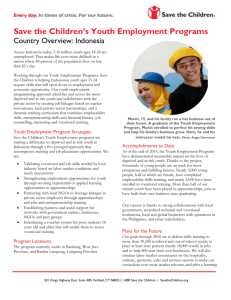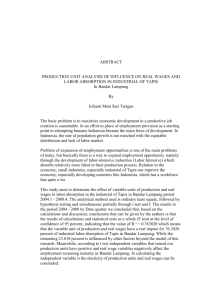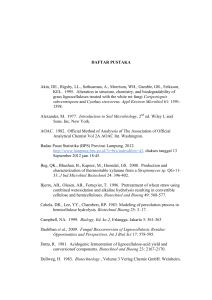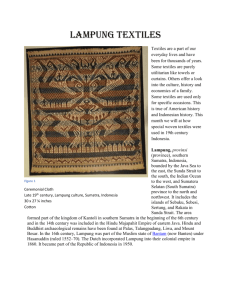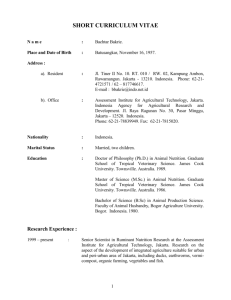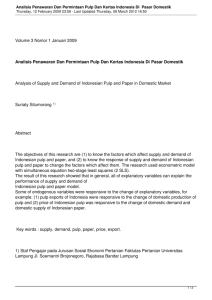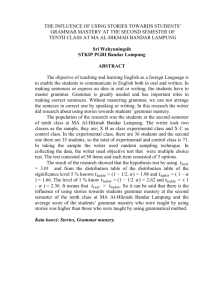THE SCHOOL OF MUSIC MONASH UNIVERSITY AND THE
advertisement
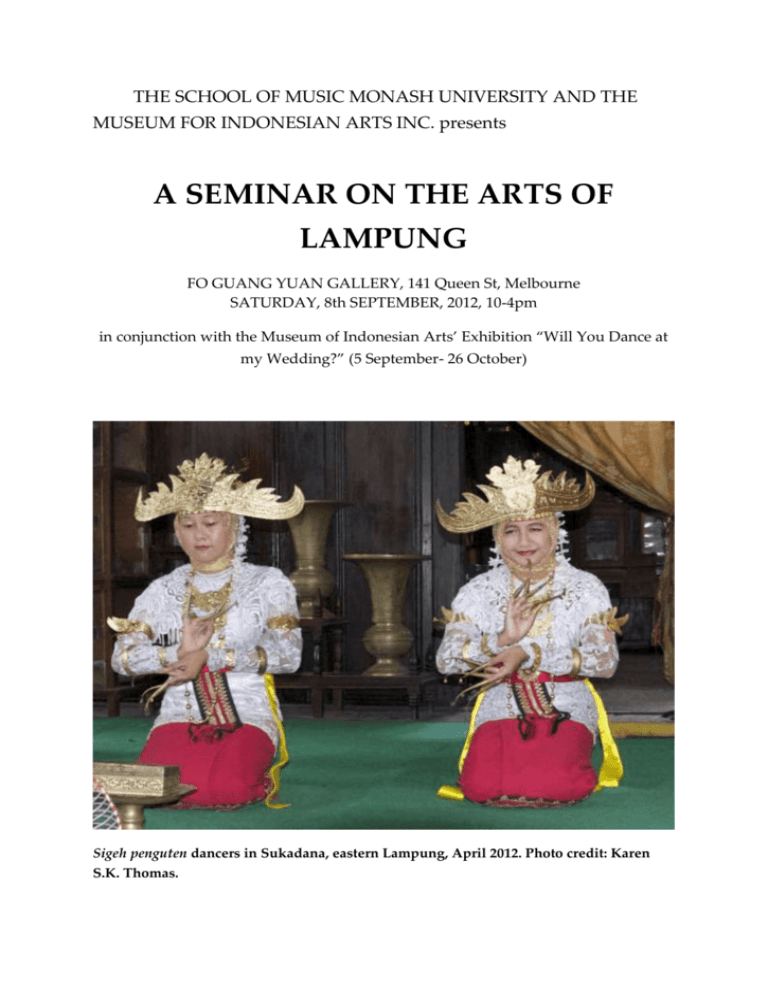
THE SCHOOL OF MUSIC MONASH UNIVERSITY AND THE MUSEUM FOR INDONESIAN ARTS INC. presents A SEMINAR ON THE ARTS OF LAMPUNG FO GUANG YUAN GALLERY, 141 Queen St, Melbourne SATURDAY, 8th SEPTEMBER, 2012, 10-4pm in conjunction with the Museum of Indonesian Arts’ Exhibition “Will You Dance at my Wedding?” (5 September- 26 October) Sigeh penguten dancers in Sukadana, eastern Lampung, April 2012. Photo credit: Karen S.K. Thomas. PROGRAM WELCOME by Halina Nowicka of the Museum of Indonesian Arts and Margaret Kartomi of the School of Music-Conservatorium, Monash University 10.15 Official Opening of the Seminar by the Indonesian Consul-General for Victoria and Tasmania, Bp Irmawan Emir Wisnandar PAPERS Chair: Dr David Mitchell, Museum of Indonesian Arts 10.25 “The tapis textiles as status symbols at weddings in Lampung” Ibu Irmawan Emir Wisnandar 10.40 “The Beauty and Meaning of the Palepai Ship-Cloths of Lampung” Nani Hardjo Pollard 11.00 “The Sakura Masked Theatre in West Lampung” Dr Karen Thomas 11.30 12.00 MORNING TEA “Improvisation and Vocal Style in a Performance of the Traditional Lampung Welcome Song, ‘Pisa’an’” Helen Catanchin 12.30 Performance of Sigeh Penguten, a traditional dance from eastern Lampung, by Indija Mahjoeddin 1.00 LUNCH Chair: Dr Joel Crotty, School of Music-Conservatorium, Monash University 2.00 “Lampung’s Official Traditional Popular Song Inangku Lampung” Bronia Kornhauser 2.30 “Continuity and Aesthetic Developments in the Cetik Kipas Dance” Indija Mahjoeddin 3.00 “Lampung’s Musical Symbol – the Gamolan in Historical and Social Context” Margaret Kartomi 3.30- 4.00 Discussion and video about Lampung arts *** ABSTRACTS 1. Ibu Irmawan Emir Wisnandar , Indonesian Consulate-General for Victoria and Tasmania “The tapis textiles as status symbols at weddings in Lampung” This talk about the designs and functions of Lampung’s tapis textiles is based on a display of representative samples. Traditionally the tapis was a sacred status symbol worn only during weddings and ceremonies to confer traditional titles of the highest class, such as family members of the community elders and chiefs. 2. Nani Hardjo Pollard, The University of Melbourne “The Beauty and Meaning of the Palepai Ship-Cloths of Lampung” Based on a display of textiles, this paper discusses the history and functions of Lampung’s ship-cloths (palepai), so-called because of their ship motives of ancient origins. As heirlooms they are important ceremonial adjuncts in weddings and other traditional ceremonies. Up until the 1920s, Lampung had a rich and varied weaving tradition using a supplementary weft technique which enabled coloured silk or cotton threads to be superimposed on a plainer cotton background. The most prominent was the palepai, ownership of which was restricted to the Lampung aristocracy of the Kalianda Bay area. There were two types of smaller cloths, known as tatibin and tampan, which could be owned and used by all levels of Lampung society. 3. Karen Thomas, Independent Scholar, Melbourne “The Sakura Masked Theatre in West Lampung” The ancient masked theatre genre sakura of West Lampung and its related form tupping in the south is normally performed by an all-male cast in ceremonial procession. The masks with their intentionally deformed human and ogre-ish faces aim to hide the identity of the actor in his efforts to repel threatening spirits from the community and to assist in the cleansing of the village. At the same time, actors are charged with evoking benevolent ancestral and nature spirits through noisy, amusing stunts to the accompaniment of rebana rhythms and the music of the talo balak orchestra with the intention of protecting specific individuals undergoing a transition of status, as in a wedding or other rites of passage. 4. Helen Catanchin, Monash University “Improvisation and Vocal Style in a Performance of the traditional Lampung Welcome Song, ‘Pisa’an’” This paper discusses the improvisatory elements, vocal style, word-music relationships and other stylistic aspects of a performance of the most popular song to welcome important guests at domestic ceremonies in Lampung such as a tooth filings, circumcisions or weddings, and formal government and commercial ceremonies. 5. Bronia Kornhauser, Monash University “Lampung’s Official Traditional Popular Song Inangku Lampung” The song “Inangku di Lampung” is a symbol of regional pride and as such enjoys enormous popularity in Lampung, particularly in the coastal towns and villages of the province. The cosmopolitan nature of the populations in those areas may be one of the reasons that the majority of listeners readily embrace music from a variety of cultures, some songs even becoming part of traditional repertoire. Advances in communications technology have also been responsible for the infiltration of ostensibly foreign music styles and ideas into local practice. However, at the point of reception of any so-called foreign music, listeners may also need a familiar perspective from which to interpret and understand the music in order to appreciate, accept and even popularise it. Such is the case with “Inangku di Lampung” which, in the renditions that I have heard, sounds like a rock ballad, and which I have therefore defined as a ‘traditional popular’ song. The combination of these two descriptors may nevertheless be considered somewhat unusual when one interprets ‘popular music’ as the relatively recent global phenomenon emanating from America (and often called ‘pop music’), and ‘traditional music’ as the songs and instrumental pieces associated with local culture and handed down, mostly via oral transmission, through the generations. This paper will explore some of the ways in which a number of elements found in popular music generally and in “Inangku di Lampung” in particular may be construed from a traditional music perspective. 6. Indija Mahjoeddin, Monash University "Continuity and Aesthetic Developments in Tari Cetik Kipas" There is a well-known and frequently performed dance from Melinting, East Lampung often referred to simply as Tari Melinting. In fact it is one of several Melinting dances and is more correctly called Tari Cetik Kipas. This paper compares the original traditional/adat dance Tari Cetik Kipas and its “modern creation”/kreasi baru counterpart, Tari Cetik Melinting based on the findings of a project led by the current Ratu, Sultan Melinting, that reconstructed and recorded two key performances demonstrating the presumed evolutionary history of the dance, in forms originally performed in 1930 and 1965. The paper wlll discuss changes evident in the movement vocabulary, choreography, accompaniment and costumes in a dance that continues to evolve whilst arguably retaining a role comparable with its original function. 7. Margaret Kartomi, Monash University “Lampung’s Contemporary Musical Icon - the Gamolan - and its Historical and Social Context” The gamolan is a seven- or eight-key xylophone made of a specially resonant variety of bamboo found deep in northwest Lampung’s forests. It is of considerable cultural interest on three main counts: (i) its uniquely resonant, sweet sound when played by a pair of expert musicians in a gong and drum ensemble (talo balok) (ii) its name – gamolan, which denoted a single instrument in 14th century Java but later became the name of a whole Javanese orchestra - the gamelan, from the mid-second millennium CE, and (iii) the fact that a similar instrument is carved on the 9th century Mahayana-Buddhist Borobudur temple in nearby Java, which suggests that the instrumental type is of great age. The first published mention of the gamolan appears in the Indonesian Arts Society’s publication, Musical Instruments of Indonesia, which contains a photo and description of a gamolan that I acquired in 1983 in Liwa, northwest Lampung. Traditionally the instrument is played in ensemble at domestic ceremonies such as circumcisions and weddings as well as religious and national day celebrations. Since the mid-1990s its use has spread widely throughout the province as thousands of Lampung’s school children learnt to play it as an extracurricular activity. At the First International Seminar on the Gamolan in Bandar Lampung in September 2011 it was declared Lampung’s official musical instrument, and it is now being patented as such. In December 2011 the Indonesian Record Museum awarded a certificate to the Governor of Lampung Drs Sjachroeddin ZP for presiding over a 25-hour marathon gamolan playing festival when 25 groups of 25 school children played gamolan for 25 hours without a break. Along with Lampung province’s famous textiles and traditional long fingernail and fan dances, the gamolan is now recognised as an icon of Lampung’s identity “Kain Palepai or Ship Cloths made with a supplementary weft technique are usually made of cotton thread. These textiles are found in Krui in Lampung and Pasemah and Palembang in South Sumatra. Why ship? Apart from the trade and commerce which flourished in South East Asia, ships also symbolizes life’s transitions which represent the life journey. Ship cloths are also used in religious rituals. Since the production of the cloth stopped, today ship cloths are highly prized by collectors”.
